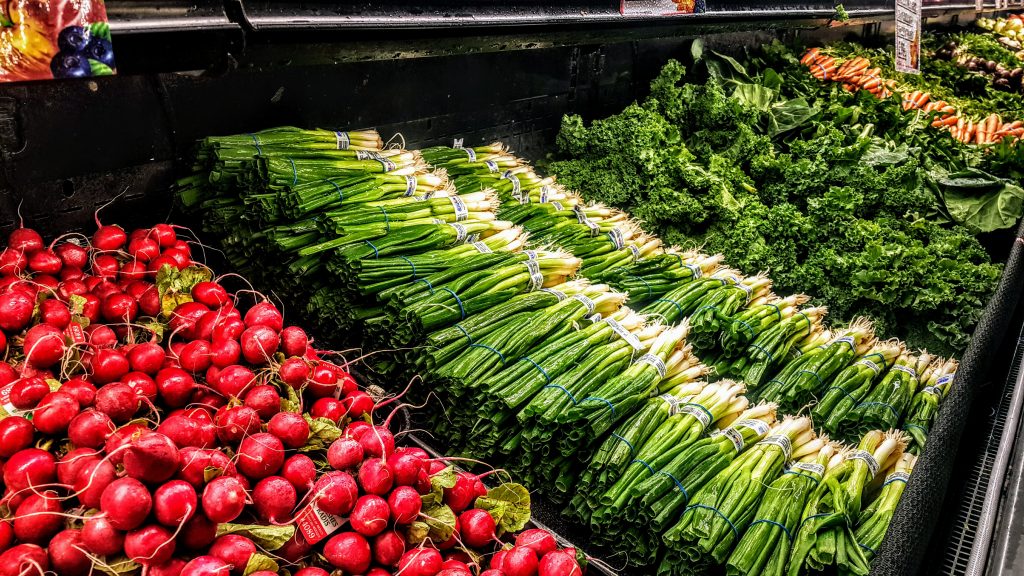By Melodie Ho, RD
We all know that eating lots of vegetables and fruits is important for good health. But it can sometimes be a challenge to include a variety of them in our diets when prices fluctuate greatly throughout the different seasons. In Canada, we have the opportunity to enjoy a wide range of reasonably priced fresh produce during the summer months from asparagus to broccoli, from cherries to apples. But many of these wonderful vegetables and fruits begin to disappear from the store or are available in limited quantities at much higher prices. This can really have an impact on our grocery budgets and our ability to enjoy variety.

Seasonal Eating
A great way to include many different types of produce in our day-to-day meals all year round is to try seasonal eating. Many of us tend to purchase the same handful of vegetables and fruits at the grocery store whether they are in season or not. These may be local options during Canada’s growing season but are likely traveling many miles from other countries to get to our grocery stores during the winter months. Rather than buying produce that is imported, try focusing on locally grown in Canada options more often.
Seasonal eating is a wonderful way to enjoy produce that has been picked at the peak of growing season and is full of flavour. It’s also an opportunity to support local farmers in your surrounding areas that are working hard to bring healthy vegetables and fruits into the grocery stores. Most importantly, with some meal planning and strategies to preserve produce for later use, you can stretch your grocery budget further.
Summer and Fall: In Canada, enjoying a wide range of local produce during the summer months can be fairly easy with well-priced options popping up in grocery stores each week. Beans, leafy greens, beets, peppers, berries, and corn are only some of the many locally grown vegetables and fruits that are harvested in summer and fall.
Winter and Spring: Although summer tends to be the easiest season to buy well-priced fresh vegetables and fruits, there are still many local options available in the winter because of cold storage and greenhouse growing technologies. Cabbage, apples, root vegetables like carrots, potatoes and turnips, and squash among others are harvested in the fall but are available year round at reasonable prices in stores. Produce such as peppers, lettuce and tomatoes can also be grown throughout the winter months in many parts of Canada in greenhouses so these are often available in store and may be priced well.
Canning and Preserving
Many of our favourite summer vegetables and fruits are no longer in-store during the winter months or may be available as quite expensive, imported versions. To enjoy local summer produce year round, preserving them by canning or freezing is a great cost-saving option. Items like fruit jams, tomato sauces, and pickled vegetables can be preserved in jars to be enjoyed throughout the winter. To learn more about canning different foods, click here. Many vegetables and fruits freeze extremely well and will retain their nutritional value such as broccoli, cauliflower, corn and strawberries among many others. Blanching is required for vegetables to preserve their colour, texture and nutrients. For techniques on how to freeze produce, here’s a great tipsheet.
Frozen, Canned and Dried Options In-Store
With our food supply offering an abundance of options, we’re fortunate to have access to produce in frozen, canned and dried varieties. These make it easier for us to include vegetables and fruits in our meals and snacks throughout the year. Just as freezing local produce on our own will preserve the quality and nutrition, buying frozen vegetables and fruit in-store is a nutritious, cost-effective and convenient option during the winter months and all year round. Canned vegetables and fruits are also healthy options but can sometimes contain a lot of sodium or added sugar. Choosing canned vegetables with no added salt and canned fruits that are packed in juice rather than syrup can mitigate this concern. Dried vegetables and fruits also have a place in a healthy diet. Not only are they convenient and cost-effective, they are easy to use in soups, stews, casseroles and baked goods. Many of the frozen, canned and dried options in grocery stores use Canadian-grown produce so checking the food labels can help with choosing which brands to buy.
Melodie Ho is a Registered Dietitian. She was the Program Coordinator for the Farm to School Manitoba program. Melodie has a strong passion for the farm to table movement and its positive impact on local farmers and producers, the local economy and sustainable agriculture.






